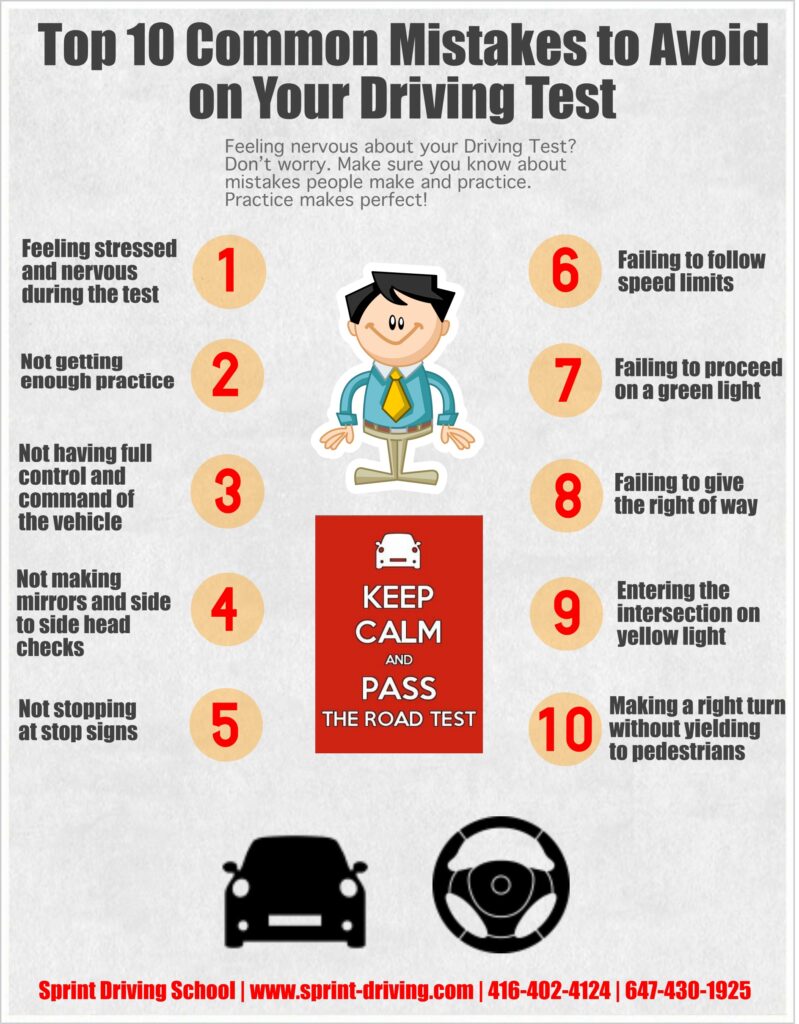It may come as a surprise, but one of the most common reasons people fail driving tests is due to insufficient observation. Frequently, learners overlook checking their mirrors or blind spots before maneuvers, which can be a critical error. This simple yet crucial aspect can often be the determining factor in a driving test outcome.
Misperceptions around driving tests have existed for decades, but data emphasizes the importance of observation. Studies show that over 37% of driving test failures are attributed to poor observation skills. Focusing on enhancing awareness and checking mirrors consistently can drastically improve one’s chances of passing.

What is the most common fail in a driving test?
One of the most common reasons people fail their driving test is due to poor observation. Often, new drivers don’t check their mirrors and blind spots consistently. This lack of awareness can lead to dangerous situations on the road. Examiners look for these habits because they are critical to safe driving. Without good observation skills, drivers are more likely to miss important details.
Another frequent cause of failure is incorrect use of signals. Many test takers forget to signal or use them incorrectly. This can confuse other drivers and cause accidents. Signals are an essential part of communication on the road. Therefore, not using them properly can result in an instant fail during the test.
Handling junctions poorly is also a big issue for new drivers. Drivers often approach junctions too fast or stop in the wrong place. This can create hazardous conditions, especially in busy areas. At junctions, drivers need to be both cautious and precise. These mistakes are easy to make but hard to correct during the test.
Driving too fast is another common reason for failing the test. Speed limits are there for safety reasons, and not following them can be dangerous. Examiners pay close attention to how test takers manage their speed. Keeping a proper speed shows that the driver understands and respects the rules of the road. Consistent adherence to speed limits is crucial for passing the test and for overall road safety.
Mirror and Observation Lapses
One of the most significant mistakes during a driving test is poor use of mirrors. Test takers often forget to check their mirrors before turning or changing lanes. This can result in accidents or near misses. Mirrors help drivers keep track of what’s happening around their vehicle. Neglecting them is a sure way to make driving less safe and fail the test.
Observation lapses also include failing to check blind spots. These are areas around the car that aren’t visible through mirrors. Properly checking blind spots is crucial when merging or changing lanes. Many new drivers overlook this step, leading to dangerous situations. Examiners are strict about this because it’s vital for safety.
Reaction time is another aspect affected by poor observation. If a driver doesn’t scan the road effectively, their reaction time may be slower. This can be dangerous in unpredictable situations. Drivers must stay alert and continuously observe their surroundings. Practice can improve these skills significantly.
To reduce observation-related errors, consider these tips:
- Always check mirrors before any maneuver.
- Make it a habit to glance at mirrors regularly while driving.
- Always turn your head to check blind spots before changing lanes.
- Stay focused and keep distractions to a minimum.
Incorrect Use of Signals
Failing to use signals correctly is a common mistake in driving tests. Many learners forget to signal when making turns or changing lanes. This can confuse other drivers and lead to accidents. Proper signaling is essential for clear communication on the road. Without it, other road users may not understand your intentions.
Sometimes, drivers use signals too early or too late. Timing is crucial when it comes to signaling. Signaling too early can mislead other drivers about your intentions. On the other hand, signaling too late doesn’t give others enough time to react. Perfecting the timing of your signals is key to safe driving.
Another common issue is forgetting to cancel the signal after the maneuver. An ongoing signal can confuse other drivers. They might think you are planning another turn or lane change. Always remember to turn off the signal once you have completed your action. This simple step can prevent misunderstanding on the road.
Here are some tips to improve signal use:
- Always signal well before turning or changing lanes.
- Check your mirrors before signaling.
- Cancel your signal after completing the maneuver.
- Practice makes perfect, so keep practicing your signaling.
Poor Handling of Junctions
Poor handling of junctions is a common reason for failing driving tests. Approach speed is often too fast, making it hard to stop safely. Many learners fail to judge their distance correctly. This can lead to abrupt stops or overshooting the junction. Proper speed control is crucial for navigating junctions safely.
Another issue is stopping in the wrong spot. Some drivers stop too early, causing confusion for other road users. Others stop too late, risking a collision. Knowing where to stop is key for safe junction handling. Practice helps in getting this right every time.
Failing to observe the right of way is also problematic. Many new drivers do not know when they should yield. This can cause dangerous situations at busy junctions. It’s important to understand who has the right of way in different scenarios. This helps reduce the risk of accidents.
Let’s not forget about signal usage at junctions. Incorrect signaling can mislead other drivers. Always signal your intentions early and clearly. This ensures that everyone knows what you plan to do. Proper communication is essential for safe driving.
Tips for better junction handling:
- Approach at a controlled speed.
- Stop at the correct spot.
- Understand right-of-way rules.
- Use signals clearly and early.
Key Factors Contributing to Observation Errors
Distractions inside the car play a significant role in observation errors. Passengers, music, and mobile phones can divert a driver’s attention. This can result in missing crucial visual cues. Keeping distractions to a minimum is important for focused driving. A clutter-free environment helps maintain attention on the road.
Inexperience is another major factor. New drivers often lack the practice needed to develop good observation habits. They may not check mirrors frequently or miss blind spots. Experience on the road is essential for building these habits. Repeated practice helps in becoming more aware of surroundings.
Nervousness can also impair observation. The stress of a driving test can make learners forget basic checks. They may rush through actions without proper observation. Taking deep breaths and staying calm can improve focus. Relaxed drivers tend to make fewer mistakes.
Weather conditions contribute to observation errors as well. Rain, fog, or bright sunlight can obscure vision. Drivers need to adjust their observation techniques accordingly. Slower speeds and increased mirror checks can help. Being aware of weather conditions is crucial for safe driving.
Fatigue affects a driver’s ability to observe effectively. Tired drivers have slower reaction times and may miss important signals. It’s vital to be well-rested before driving. Ensuring adequate sleep helps maintain alertness.
Here are some tips to reduce observation errors:
- Minimize distractions inside the vehicle.
- Gain more driving experience through practice.
- Stay calm and focused during the test.
- Adjust observations according to weather conditions.
- Ensure adequate rest before driving.
Improving Observation Skills Before the Driving Test
Practice makes perfect when it comes to driving. Regularly practicing with a qualified instructor can significantly improve observation skills. Focus on checking mirrors, blind spots, and the road ahead. Repetition will help make these actions a habit. Frequent practice builds confidence and awareness.
Simulating test conditions can be beneficial. Drive in various traffic situations and road types. This can include busy city streets, quiet neighborhoods, and highways. The more diverse the experience, the better prepared you will be. This helps in adapting observation techniques to different conditions.
Using a checklist can help track and improve observation skills. Make a list of key observations to perform during each drive:
- Check rearview and side mirrors regularly.
- Scan the road ahead for any hazards.
- Always check blind spots before changing lanes.
- Observe traffic signals and signs carefully.
- Make eye contact with other drivers where possible.
Another useful method is to review each drive with your instructor. Discuss any missed observations or errors. Get feedback on how to improve. This can help in identifying and fixing weak spots. Constructive criticism is valuable for better understanding and improving skills.
Utilizing driving simulators can also be effective. These tools provide a controlled environment to practice observation. They can mimic different driving scenarios. This helps in refining skills without real-world risks. Simulators can be a great addition to hands-on practice.
Consistent practice and feedback will aid in mastering observation skills. Stay focused and dedicated to improving. The result will be safer and more confident driving, increasing the likelihood of passing the driving test on the first try.
Conclusion
Successfully passing a driving test requires excellent observation skills. Common failures often stem from lapses in mirror checking, incorrect signaling, and poor junction handling. Addressing these issues through focused practice and feedback can greatly improve test outcomes.
Remember that safety is the top priority. Consistent and vigilant observation ensures safer driving for everyone. By refining these skills and staying dedicated, you can enhance your driving proficiency and increase your chances of passing the test.

